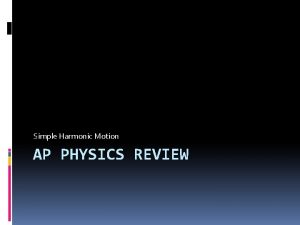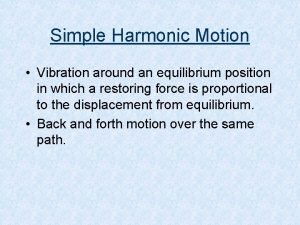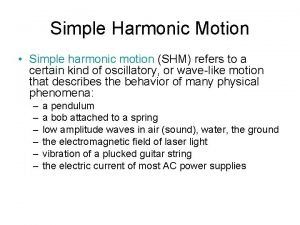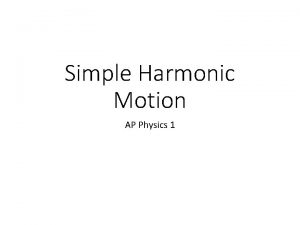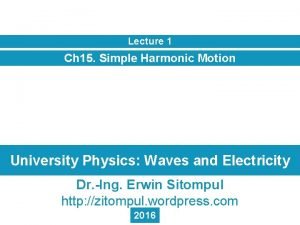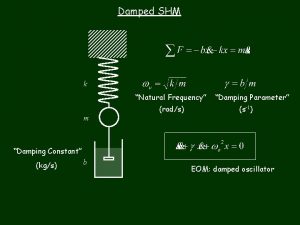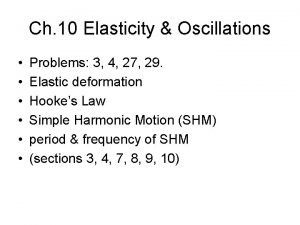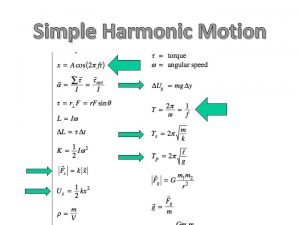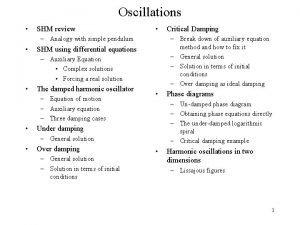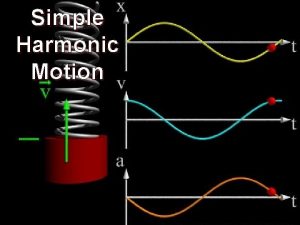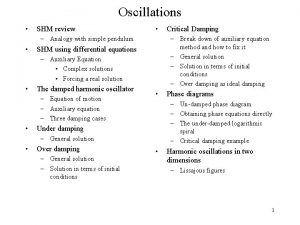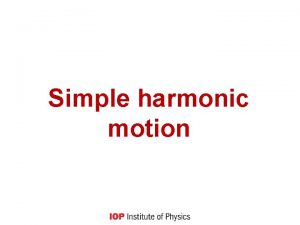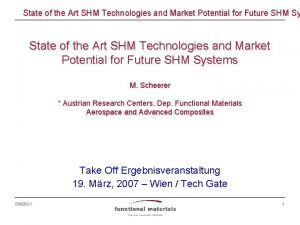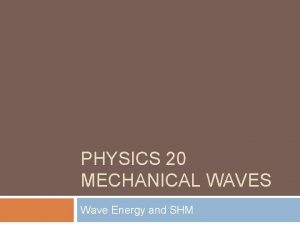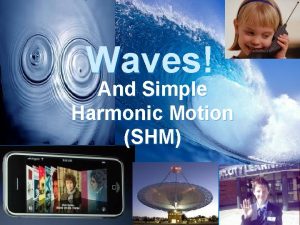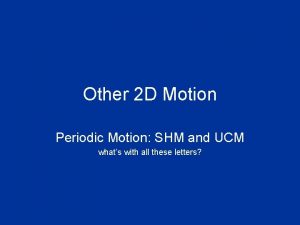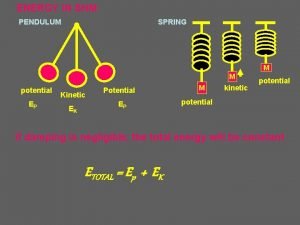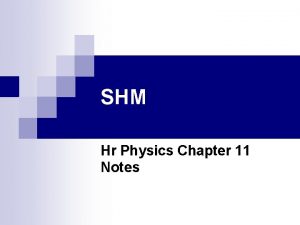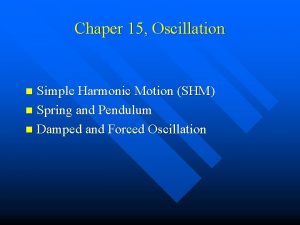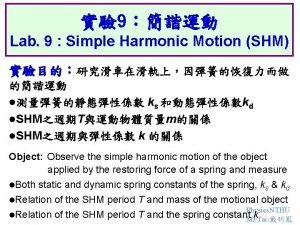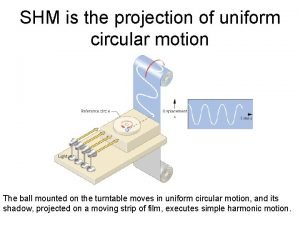QM Review and SHM in QM Review and























- Slides: 23

QM Review and SHM in QM Review and Tunneling Calculation. No quiz but some clicker questions. Read about the Schrodinger Equation in 3 dimensions and 3 -D particle in a box for next time. Copyright © 2012 Pearson Education Inc.

Review: The Schrödinger equation in 1 -D: Stationary states • If a particle of mass m moves in the presence of a potential energy function U(x), the one-dimensional Schrödinger equation for the particle is • If the particle has a definite energy E, the wave function Ψ(x, t) is a product of a time-independent wave function Ψ (x) and a factor that depends on time t but not position. For such a stationary state the probability distribution function |Ψ (x, t)|2 = |Ψ (x)|2 does not depend on time. • The time-independent one-dimensional Schrödinger equation for a stationary state of energy E is Copyright © 2012 Pearson Education Inc.

Review: Particle in a finite potential well I • A finite potential well is a region where potential energy U(x) is lower than outside the well, but U(x) is not infinite outside the well (see Figure below). • In Newtonian physics, a particle whose energy E is less than the “height” of the well can never escape the well. In quantum mechanics the wave function of such a particle extends beyond the well, so it is possible to find the particle outside the well. Copyright © 2012 Pearson Education Inc.

Particle in a finite potential well II • Figure (bottom left) shows the stationary-state wave functions Ψ (x) and corresponding energies for one particular finite well. • Figure (bottom right) shows the corresponding probability distribution functions |Ψ (x)|2. Copyright © 2012 Pearson Education Inc.

Application of QM potentials: QM semiconductor dots Nanometer-sized (nm) particles of a semiconductor such as Cd. Se Discovered by Russian physicist Alexey Ekimov in St. Petersburg in 1981 The fluorescence color under UV is determined by the size of the dot. (5 -6 nm orange or red; 2 -3 nm blue or green) Can be injected into patients for medical research and treatment (tagging and treating cancer cells). Also solar cell and computing applications Copyright © 2012 Pearson Education Inc.

QM Potential Well Clicker The first three wave functions for a finite square well are shown. The probability of finding the particle at x > L is A. least for n = 1. B. least for n = 2. C. least for n = 3. D. the same (and nonzero) for n = 1, 2, and 3. E. zero for n = 1, 2, and 3. Copyright © 2012 Pearson Education Inc.

QM Potential Well Clicker The first three wave functions for a finite square well are shown. The probability of finding the particle at x > L is A. least for n = 1. B. least for n = 2. C. least for n = 3. D. the same (and nonzero) for n = 1, 2, and 3. E. zero for n = 1, 2, and 3. Copyright © 2012 Pearson Education Inc.

Review: Potential barriers and tunneling • The figure (below left) shows a potential barrier. In Newtonian physics, a particle whose energy E is less than the barrier height U 0 cannot pass from the left-hand side of the barrier to the right-hand side. • Look at the wave function Ψ (x) for such a particle. The wave function is nonzero to the right of the barrier, so it is possible for the particle to “tunnel” from the left-hand side to the right-hand side. Copyright © 2012 Pearson Education Inc.

Applications of tunneling • A scanning tunneling microscope measures the atomic topography of a surface. It does this by measuring the current of electrons tunneling between the surface and a probe with a sharp tip (see Figure below). • An alpha particle inside an unstable nucleus can only escape via tunneling (see Figure on the right). UH Physics Professor Klaus Sattler has a scanning tunneling microscope Copyright © 2012 Pearson Education Inc.

Example of tunneling calculation Tunneling probability A 2. 0 e. V electron encounters a rectangle barrier 5. 0 e. V high. What is the tunneling probability if the barrier width is 0. 50 nm ? Find G and κ Copyright © 2012 Pearson Education Inc.

Example of tunneling calculation Tunneling probability A 2. 0 e. V electron encounters a rectangle barrier 5. 0 e. V high. What is the tunneling probability if the barrier width is 0. 50 nm ? Copyright © 2012 Pearson Education Inc.

Example of tunneling calculation Tunneling probability A 2. 0 e. V electron encounters a rectangle barrier 5. 0 e. V high. What is the tunneling probability if the barrier width is 0. 50 nm ? Reducing the width L by a factor of two, increasing the tunnel probability of a factor of 7300. Exponential sensitivity in the barrier factor. Copyright © 2012 Pearson Education Inc.

Clicker Tunneling Question A potential-energy function is shown. If a quantum-mechanical particle has energy E < U 0, it is impossible to find the particle in the region A. x < 0. B. 0 < x < L. C. x > L. D. misleading question— the particle can be found at any x Copyright © 2012 Pearson Education Inc.

Clicker Tunneling Question A potential-energy function is shown. If a quantum-mechanical particle has energy E < U 0, it is impossible to find the particle in the region A. x < 0. B. 0 < x < L. C. x > L. D. misleading question—the particle can be found at any x Copyright © 2012 Pearson Education Inc.

A comparison of Newtonian and quantum oscillators • Let’s work out Ψ (x) for the QM harmonic oscillator. Copyright © 2012 Pearson Education Inc.

A comparison of Newtonian and quantum oscillators • Let’s work out Ψ (x) for the QM harmonic oscillator. Why is (d) the only possibility ? Copyright © 2012 Pearson Education Inc.

A comparison of Newtonian and quantum oscillators • Using the boundary condition, we obtain Ψ (x) for the QM harmonic oscillator and its energy levels. These are the possible energies of the QM harmonic oscillator Note that ω=√(k’/m) but that n starts from n=0 ! The ground state has n=0; no QM solution with energy equal to zero. Copyright © 2012 Pearson Education Inc.

A comparison of Newtonian and quantum oscillators • Figure (below, top) shows the first four stationary-state wave functions Ψ (x) for the harmonic oscillator. A is the amplitude of oscillation in Newtonian physics. • Figure (below, bottom) shows the corresponding probability distribution functions |Ψ (x)|2. The blue curves are the Newtonian probability distributions. Copyright © 2012 Pearson Education Inc.

A comparison of Newtonian and quantum oscillators Classical, confined to –A, A; QM SHM is different. � Copyright © 2012 Pearson Education Inc.

Clicker question on QM Harmonic Oscillator The figure shows the first six energy levels of a quantum-mechanical harmonic oscillator. The corresponding wave functions A. are nonzero outside the region allowed by Newtonian mechanics. B. do not have a definite wavelength. C. are all equal to zero at x = 0. D. Both A. and B. are true. E. All of A. , B. , and C. are true. Copyright © 2012 Pearson Education Inc.

A 40. 8 The figure shows the first six energy levels of a quantummechanical harmonic oscillator. The corresponding wave functions A. are nonzero outside the region allowed by Newtonian mechanics. B. do not have a definite wavelength. C. are all equal to zero at x = 0. D. Both A. and B. are true. E. All of A. , B. , and C. are true. Copyright © 2012 Pearson Education Inc.

QM Potential Wells A particle in a potential well emits a photon when it drops from the n = 3 energy level to the n = 2 energy level. The particle then emits a second photon when it drops from the n = 2 energy level to the n = 1 energy level. The first photon has the same energy as the second photon. What kind of potential well could this be? A. an infinitely deep square potential well (particle in a box) B. a harmonic oscillator C. either A. or B. D. neither A. nor B. Copyright © 2012 Pearson Education Inc.

A 40. 9 A particle in a potential well emits a photon when it drops from the n = 3 energy level to the n = 2 energy level. The particle then emits a second photon when it drops from the n = 2 energy level to the n = 1 energy level. The first photon has the same energy as the second photon. What kind of potential well could this be? A. an infinitely deep square potential well (particle in a box) B. a harmonic oscillator C. either A. or B. D. neither A. nor B. Copyright © 2012 Pearson Education Inc.
 Ap physics 1 shm review
Ap physics 1 shm review Equilibrium position of a wave
Equilibrium position of a wave Simple harmonic motion springs
Simple harmonic motion springs Simple harmonic motion
Simple harmonic motion Ap physics 1 simple harmonic motion
Ap physics 1 simple harmonic motion Shm formula sheet
Shm formula sheet Simple harmonic motion lecture
Simple harmonic motion lecture Shm equations
Shm equations Graphical representation of shm
Graphical representation of shm Shm k
Shm k Frequency of shm formula
Frequency of shm formula Shm reference circle
Shm reference circle Vmax=aw
Vmax=aw An elastic cord is 65 cm long
An elastic cord is 65 cm long Lissajous figures in shm
Lissajous figures in shm Shm
Shm Shm
Shm Shm
Shm Shm
Shm Damped oscillation
Damped oscillation Chapter review motion part a vocabulary review answer key
Chapter review motion part a vocabulary review answer key Ap gov review final exam review
Ap gov review final exam review Nader amin-salehi
Nader amin-salehi Narrative review vs systematic review
Narrative review vs systematic review
